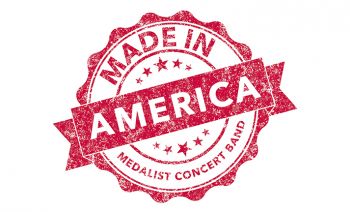Made in America: 11•10•2019
Program
The Minnesota March, by John Philip Sousa (ed. Frederick Fennell)
John Philip Sousa (1854–1932) wrote “The Minnesota March” in 1927 expressly for the University of Minnesota, and Minnesota is one of only four universities for which the “March King” composed an anthem. The idea of asking Sousa to write a “marching song” originated with the university’s band director at the time, Michael Jalma. Jalma and a committee of university officials presented the request to Sousa, who was eager to capture elements of Minnesota’s rich heritage. Plans for the 100-piece university band to introduce the new march to the student body at a convocation were thwarted when Sousa had his own band premiere the piece at the Minnesota State Fair. “The Minnesota March” was first performed on campus on October 26, 1927, to an enthusiastic audience of 2,500 students and faculty. Band director Michael Jalma wrote the rousing words to the march.
Simple Gifts: Four Shaker Songs for Concert Band, by Frank Ticheli
I. In Yonder Valley
II. Dance
III. Here Take This Lovely Flower
IV. Simple Gifts
Frank Ticheli (b. 1958) composed Simple Gifts: Four Shaker Songs in 2002 on a commission from the Tapp Middle School Band in Powder Springs, Georgia. The first song, “In Yonder Valley,” is a simple hymn in praise of nature and believed to be the oldest surviving Shaker melody. The second song, “Dance,” is from an 1830s Shaker manuscript; dancing was a key part of Shaker worship. “Here Take This Lovely Flower” is a Shaker lullaby and an example of a gift song: music received from spirits by a Shaker medium while in trance. The final song, “Simple Gifts,” is the most famous Shaker melody and may also be a gift song. “Simple Gifts” has been used in hundreds of musical settings, including Aaron Copland’s “Appalachian Spring.”
Sheltering Sky, by John Mackey
John Mackey (b. 1973) composed “Sheltering Sky” in 2012 on a commission from the Traughber and Thompson Junior High School Bands in Oswego, Illinois. Although the piece is not technically difficult, it features complex harmonies, sharp dissonances, and expressive lyricism. The piece also seems to have elements of folk songs, including “Danny Boy” and “Shenandoah,” instilling a sense of familiarity, but all the music is original. “Sheltering Sky” has been described as “a nostalgic portrait of time suspended.”
Walt Disney Band Showcase, arr. Floyd E. Werle
Floyd E. Werle (1929–2010) arranged the medley “Walt Disney Band Showcase” in 1969, and it features songs from some of the early Disney classics. Listen for “Give a Little Whistle” and “I Got No Strings” from Pinocchio (released in 1940), “Heigh Ho, Heigh Ho,” “I’m Wishing,” and “With a Smile and a Song” from Snow White (1959), and more. Werle was chief arranger for the U.S. Air Force Band from 1951 to 1967.
S.S. Eagle March, by Robert Russell Bennett
Robert Russell Bennett (1894–1981) achieved fame as an arranger, scoring hundreds of Broadway musicals and many films and television shows, but he considered his true calling to be a wind band composer. One of Bennett’s most significant band works is the symphonic suite Down to the Sea in Ships, published in 1969. The five-movement work was drawn from an NBC television documentary series, Project 20, which aired from 1954 to 1973. Bennett composed and arranged all the music for the 34 episodes of Project 20 and also rehearsed and conducted the NBC orchestra during the program’s recording sessions. “S.S. Eagle March” is the final movement of Down to the Sea in Ships.
Intermission
Liberty Fanfare, by John Williams (arr. Jim Curnow)
John Williams (b. 1932) has composed the music and served as the musical director for nearly 80 films, winning numerous awards. He is also well known for writing stirring ceremonial music, including the themes for four Olympics. Williams was commissioned to write “Liberty Fanfare” by the Statue of Liberty–Ellis Island Foundation in honor of the hundredth “birthday” of the statue. He premiered the fanfare with the Boston Pops Orchestra on June 4, 1986, and then presented it again as part of a live televised broadcast on July 4, 1986. In describing the piece, Williams stated that his intent was “to create a group of American airs and tunes of my own invention that [would] give some sense of the event and the occasion.”
No Finer Calling, by Julie Giroux
I. Integrity Fanfare and March
II. Far from Home
III. Honor Above All
Julie Giroux (b. 1961) has scored more than 100 movies and television shows and arranged music for a range of popular singers, from Michael Jackson to Reba McIntyre. Giroux wrote No Finer Calling, a three-movement symphony, to celebrate the sixtieth anniversary of the U.S. Air Force (1947–2007). Each movement is based on one of the core values of the organization: Integrity First, Service Before Self, and Excellence in All We Do. The air force adopted these core values in 1995 to set a common standard for conduct and instilled them at every level of the organization by the Air Education and Training Command and the U.S. Air Force Academy. No Finer Calling is dedicated to Colonel Arnald D. Gabriel, who served from 1964 to 1985 as the commander/conductor of the internationally recognized U.S. Air Force Band, Symphony Orchestra, and Singing Sergeants.
America, the Beautiful, by K. L. Bates and S. A. Ward (arr. Carmen Dragon)
Katharine Lee Bates (1859–1929), a Wellesley College instructor, wrote the lyrics to “America, the Beautiful” as a poem in 1893. The poem was published two years later and often sung to folk tunes and other popular melodies that fit the verse. One of those melodies was the hymn “Materna,” by Samuel A. Ward (1847–1903). The words and music were finally published together in 1910.
Stars and Stripes Forever, by John Philip Sousa
“Stars and Stripes Forever” is generally considered the greatest work of John Philip Sousa (1854–1932). In his biography, Sousa recounts writing the march on Christmas Day in 1896, while on a trip to Europe and hearing about the death of a close friend. He composed the piece in his head and wrote it down later after returning to the United States. “Stars and Stripes” was made the National March of the United States in 1987 by an act of Congress.
Program notes by Susan Freese
Upcoming Performances
Join our mailing list
Subscribe to our email newsletter to learn about upcoming concerts.


